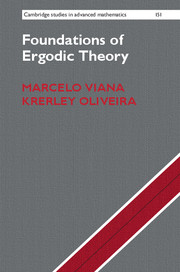Book contents
- Frontmatter
- Contents
- Preface
- 1 Recurrence
- 2 Existence of invariant measures
- 3 Ergodic theorems
- 4 Ergodicity
- 5 Ergodic decomposition
- 6 Unique ergodicity
- 7 Correlations
- 8 Equivalent systems
- 9 Entropy
- 10 Variational principle
- 11 Expanding maps
- 12 Thermodynamic formalism
- Appendix A Topics in measure theory, topology and analysis
- Hints or solutions for selected exercises
- References
- Index of notation
- Index
10 - Variational principle
Published online by Cambridge University Press: 05 February 2016
- Frontmatter
- Contents
- Preface
- 1 Recurrence
- 2 Existence of invariant measures
- 3 Ergodic theorems
- 4 Ergodicity
- 5 Ergodic decomposition
- 6 Unique ergodicity
- 7 Correlations
- 8 Equivalent systems
- 9 Entropy
- 10 Variational principle
- 11 Expanding maps
- 12 Thermodynamic formalism
- Appendix A Topics in measure theory, topology and analysis
- Hints or solutions for selected exercises
- References
- Index of notation
- Index
Summary
In 1965, the IBM researchers R. Adler, A. Konheim and M. McAndrew proposed [AKM65] a notion of topological entropy, inspired by the Kolmogorov–Sinai entropy that we studied in the previous chapter, but whose definition does not involve any invariant measure. This notion applies to any continuous transformation in a compact topological space.
Subsequently, Efim Dinaburg [Din70] and Rufus Bowen [Bow71, Bow75a] gave a different, yet equivalent, definition for continuous transformations in compact metric spaces. Despite being a bit more restrictive, the Bowen– Dinaburg definition has the advantage of making more transparent the meaning of this concept: the topological entropy is the rate of exponential growth of the number of orbits that can be distinguished within a certain precision, arbitrarily small. Moreover, Bowen extended the definition to non-compact spaces, which is also very useful for applications.
These definitions of topological entropy and their properties are studied in Section 10.1 where, in particular, we observe that the topological entropy is an invariant of topological equivalence (topological conjugacy). In Section 10.2 we analyze several concrete examples.
The main result is the following remarkable relation between the topological entropy and the entropies of the transformation with respect to its invariant measures:
Theorem 10.1 (Variational principle). If f : M → M is a continuous transformation in a compact metric space then its topological entropy h(f) coincides with the supremum of the entropies hμ(f) of f with respect to all the invariant probability measures.
This theorem was proved by Dinaburg [Din70, Din71], Goodman [Goo71a] and Goodwin [Goo71b]. Here, it arises as a special case of a more general statement, the variational principle for the pressure, which is due to Walters [Wal75].
The pressure P(f,ϕ) is a weighted version of the topological entropy h(f), where the “weights” are determined by a continuous function ϕ : M → ℝ, which we call a potential. We study these notions and their properties in Section 10.3. The topological entropy corresponds to the special case when the potential is identically zero. The notion of pressure was brought from statistical mechanics to ergodic theory by the Belgium mathematician and theoretical physicist David Ruelle, one of the founders of differentiable ergodic theory, and was then extended by the British mathematician Peter Walters.
Information
- Type
- Chapter
- Information
- Foundations of Ergodic Theory , pp. 301 - 351Publisher: Cambridge University PressPrint publication year: 2016
